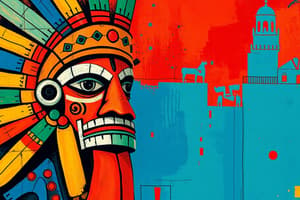Podcast
Questions and Answers
Who was elected by a council of nobles in Tenochtitlan?
Who was elected by a council of nobles in Tenochtitlan?
- The High Priest
- The City Treasurer
- The Great Speaker (correct)
- The Main Voice
What was the purpose of the Rack of Skulls (tzompantli)?
What was the purpose of the Rack of Skulls (tzompantli)?
- To honor the gods with offerings
- To hold the heads of those sent to the house of the sun (correct)
- To display trophies from the ball game
- To serve as a warning to enemies
How was the ball-game court in Tenochtitlan designed?
How was the ball-game court in Tenochtitlan designed?
- Flat with no walls or boundaries
- Narrow in the center and wide at each end (correct)
- Circular with a deep pit in the center
- Wide at the center and narrow at both ends
What material were the houses of the rich nobles (pipiltin) likely constructed from?
What material were the houses of the rich nobles (pipiltin) likely constructed from?
What would happen to the losing team in the ball game?
What would happen to the losing team in the ball game?
What did Huitzilopochtli instruct the priest to find?
What did Huitzilopochtli instruct the priest to find?
Which Great Speaker completed the construction of the temple in 1487?
Which Great Speaker completed the construction of the temple in 1487?
What is the primary purpose of the School of Priests?
What is the primary purpose of the School of Priests?
How were the priests described in the content?
How were the priests described in the content?
What were the two temples at the top of the steps dedicated to?
What were the two temples at the top of the steps dedicated to?
What was a requirement for all boys in the School of Priests?
What was a requirement for all boys in the School of Priests?
Which feature is NOT associated with the Great Temple of Huitzilopochtli?
Which feature is NOT associated with the Great Temple of Huitzilopochtli?
What was a notable characteristic of the hair of the priests?
What was a notable characteristic of the hair of the priests?
Flashcards are hidden until you start studying
Study Notes
Tenochtitlan Origins
- Huitzilopochtli instructed a priest to find an eagle on a cactus devouring a serpent, leading to the founding site of Tenochtitlan.
- The Aztecs initially constructed their city from sticks and hay due to lack of stones.
- The most significant structure was the temple dedicated to Huitzilopochtli.
- Construction of the temple began around 1418 under Great Speaker Chimalpopoca and was completed in 1487 by Ahuitzotl.
The House of the Priests
- Priests had distinctive appearances, often painted and marked with self-inflicted wounds.
- They reportedly wore dark cloaks adorned with skulls and styled tall feathered headdresses.
- Priests maintained long hair, uncut and often stiff from sacrificial blood.
The Great Temple of Huitzilopochtli
- Featured twin temples: Tlaloc (blue and white) and Huitzilopochtli (red), each with large sacrifice stones.
- The temple decorations included intricately carved skulls.
Education of Priests
- Boys from affluent families attended an extensive training school to become priests, learning reading, writing, and agricultural work.
- Education was stratified; wealthier boys received a different curriculum than poorer ones.
- Both boys and girls attended school, with boys focusing on crafts and girls learning domestic skills.
Great Speaker's Palace
- The residence of the Great Speaker (Emperor), elected by a council of nobles.
- Assisted by a figure known as the Main Voice.
Temple of Quetzalcoatl
- Little remains of the Temple, with notable carvings sourced from the earlier abandoned city of Teotihuacan.
The Western Gatehouse
- The causeway connected the western gatehouse to the market area.
The Rack of Skulls
- The tzompantli displayed heads of sacrificed individuals on wooden poles supported by towers of skulls, cemented together.
The Ball-Game Park
- The ball-game was played in a large, enclosed courtyard with a narrow center and wide ends.
- Teams aimed to score by getting a rubber ball through a stone ring or into the opposing team’s area, with high stakes for the losing team.
Noble Housing
- Wealthy nobles, known as pipiltin, resided in large white houses featuring flat roofs and multiple rooms over two levels.
Studying That Suits You
Use AI to generate personalized quizzes and flashcards to suit your learning preferences.




